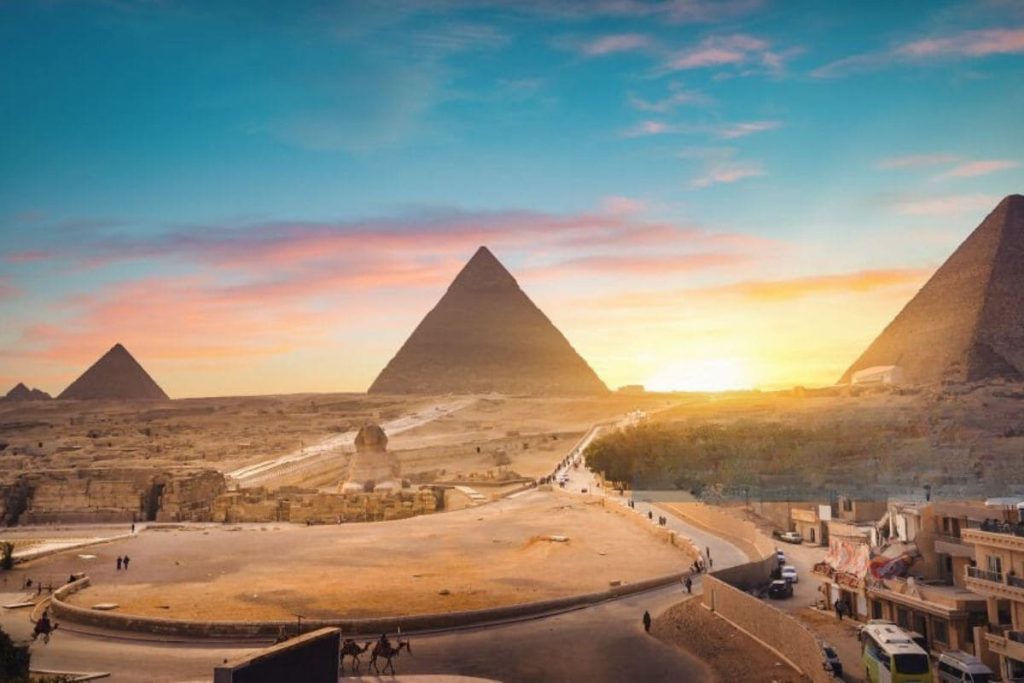Introduction
Imagine standing in the shadow of the colossal Pyramids of Egypt, feeling the weight of history beneath your feet. This is where ancient pharaohs rest, and myths come to life. The Pyramids of Egypt have fascinated travelers, historians, and dreamers for centuries. Their sheer size, architectural brilliance, and the mystery that surrounds them create an aura of wonder that’s hard to resist. From their construction techniques to the legends of hidden treasures, the pyramids are a cornerstone of Egyptian culture and history. Ready to embark on an epic journey through time? Let’s dive into the wonders of the pyramids and discover why they are an unmissable part of any Egyptian adventure.
Historical Background
When you first lay eyes on the pyramids, it’s impossible not to be awestruck by their grandeur. Imagine being transported back in time to ancient Egypt, where the sound of chisels and the sight of thousands of laborers working under the scorching sun were daily realities. The construction of these monumental structures began over 4,500 years ago during the Old Kingdom period. The most famous, the Great Pyramid of Giza, was built for Pharaoh Khufu and originally stood at 146.6 meters tall.
The techniques used to build the pyramids have long been a subject of debate and fascination. It’s believed that massive limestone blocks were quarried, transported, and meticulously assembled to create these awe-inspiring edifices. The labor force, often thought to be slaves, were in fact skilled workers who took pride in their work, fueled by a belief in the divine and the promise of eternal life.
he pyramids were more than just grand tombs; they were a testament to the Egyptians’ belief in the afterlife. Each pyramid was part of a larger complex that included temples, chapels, and smaller tombs, designed to honor the deceased pharaoh and ensure their safe passage to the afterlife. The grandeur of the pyramids reflected the pharaohs’ power and their desire to be remembered for eternity.

Great Pyramid
As you explore the different pyramids across Egypt, you’ll notice that they aren’t all the same. The evolution of pyramid construction is a story in itself, showcasing the Egyptians’ architectural ingenuity.
Step Pyramids: The Step Pyramid of Djoser in Saqqara is one of the earliest pyramids, designed by the architect Imhotep. It’s a series of stacked mastabas (flat-roofed tombs) that create a step-like structure, marking the transition from simple tombs to the more complex pyramids.
Bent Pyramids: The Bent Pyramid of Dahshur, built under Pharaoh Sneferu, is a fascinating anomaly. Its unique shape, with a noticeable bend halfway up, is believed to be the result of structural issues encountered during construction. This pyramid reflects the trial-and-error process that eventually led to the development of the true pyramids.

True Pyramids: The Great Pyramid of Giza, along with the pyramids of Khafre and Menkaure, represent the pinnacle of pyramid construction. These pyramids have smooth, angled sides and are the most iconic symbols of ancient Egypt. The Great Pyramid, with its precise alignment to the cardinal points and massive scale, remains one of the Seven Wonders of the Ancient World.
Famous Pyramids
Great Pyramid of Giza: Standing before the Great Pyramid, you can almost hear the whispers of ancient builders who toiled day and night to create this marvel. It consists of over two million limestone blocks, each weighing an average of 2.5 tons. The precision with which it was built, aligned to the cardinal points and originally covered in gleaming white casing stones, is a testament to the advanced knowledge and skill of the ancient Egyptians.
Pyramid of Khafre and the Great Sphinx: Just a stone’s throw from the Great Pyramid is the Pyramid of Khafre, often overshadowed by its more famous neighbor but equally impressive. Guarding it is the enigmatic Great Sphinx, a mythical creature with the body of a lion and the head of a pharaoh. The Sphinx stands as a sentinel, its gaze fixed eternally towards the rising sun, symbolizing strength and wisdom.
Pyramid of Menkaure: The smallest of the three pyramids in Giza, the Pyramid of Menkaure, might not boast the same grandeur as the others, but it holds its own charm. Its lower casing was made of red granite, giving it a distinctive appearance. Exploring Menkaure’s pyramid provides a more intimate glimpse into the architectural evolution and the personal ambitions of the pharaohs.
Step Pyramid of Djoser: Located in the Saqqara necropolis, the Step Pyramid of Djoser is a must-visit. It’s considered the world’s oldest monumental stone structure and represents a major leap in architectural design. As you stand before it, you can almost picture the ancient ceremonies that took place here.
Pyramids of Dahshur: The Bent Pyramid and the Red Pyramid at Dahshur are less crowded than those in Giza but equally fascinating. The Bent Pyramid, with its unusual shape, provides insight into the experimental phase of pyramid construction. The Red Pyramid, named for its reddish hue, is considered the first successful attempt at a true smooth-sided pyramid.

Pyramid of Unas: Although smaller than the grand pyramids of Giza, the Pyramid of Unas in Saqqara holds a special place in history. It’s famous for the Pyramid Texts, the oldest known religious texts in the world, inscribed on its walls. These texts offer a glimpse into the spiritual beliefs and rituals of ancient Egypt.
Pyramid of Meidum: The Pyramid of Meidum, often referred to as the “collapsed pyramid,” is another intriguing site. Its original structure was unstable, leading to its partial collapse. However, its unique design provides valuable insight into the early phases of pyramid construction. Visiting Meidum offers a chance to see an off-the-beaten-path historical site with fewer tourists.

Pyramid of Teti: Another notable pyramid in Saqqara is the Pyramid of Teti, the first ruler of the Sixth Dynasty. Though not as grand as some of the others, it’s famous for its well-preserved Pyramid Texts and offers an intimate look at the burial practices of ancient Egyptian royalty.
Visiting the Pyramids
Exploring the pyramids is more than just a sightseeing trip; it’s a journey through time. Whether you’re a history buff, an adventure seeker, or simply looking to marvel at these ancient wonders, visiting the pyramids is an unforgettable experience. Here’s everything you need to know to make the most of your visit.

Tickets and Entry Information
Visiting the pyramids requires a ticket, and there are several types available depending on what you want to see:
- General Admission: This ticket gives you access to the Giza plateau, where you can explore the Great Pyramid, Pyramid of Khafre, Pyramid of Menkaure, and the Great Sphinx. It’s the most basic ticket but offers plenty to see.
- Great Pyramid Entry: For those who want to delve deeper, this ticket allows you to enter the Great Pyramid of Giza itself. Be prepared for narrow passages and steep climbs, but the experience is worth it.
- Combination Tickets: Some tickets combine entry to multiple sites, such as the Giza plateau and the Solar Boat Museum or the Giza plateau and the Saqqara necropolis. These are great if you plan to see more in a single day.
For complete details on ticket pricing, please visit our full list of entry fees for Egypt attractions here.
Tips for Visiting:
- Timing: Visit early in the morning or late in the afternoon to avoid the heat and the crowds. The light is also better for photography during these times.
- Guides: Hiring a guide can enhance your experience, providing in-depth knowledge and context. Many guides are licensed and can be hired on-site or booked in advance.
- What to Bring: Wear comfortable walking shoes, bring water, sunscreen, and a hat. Some areas are sandy and uneven, so be prepared for a bit of a workout.
Safety Tips and Local Customs
While the pyramids are generally safe to visit, it’s important to be aware of a few local customs and safety tips:
- Respect the Site: The pyramids are a UNESCO World Heritage site. Avoid climbing on the structures or touching the inscriptions.
- Photography: Taking photos is generally allowed, but be mindful of signs indicating restricted areas. Professional photography may require a special permit.
- Local Vendors: Vendors and camel ride operators can be persistent. It’s okay to politely decline if you’re not interested. Agree on prices beforehand if you decide to make a purchase or take a ride.
Special Tours
For a truly immersive experience, consider booking a special tour. These tours often provide access to areas not available to general visitors and are led by experts in the field.
Guided Tours by Experts
Imagine walking through the ancient corridors with an Egyptologist like Dr. Zahi Hawass, who can share insights and stories you won’t find in any guidebook. Expert-led tours often include:
- Exclusive Access: Some tours offer entry to restricted areas, such as certain chambers within the pyramids or newly discovered sites.
- Historical Insights: Learn about the latest archaeological discoveries, the significance of the hieroglyphs, and the daily life of the ancient Egyptians.
Unique Experiences
Beyond the standard tours, there are several unique experiences that can make your visit to the pyramids even more memorable:
- Sunrise or Sunset Tours: Experience the pyramids in the magical light of dawn or dusk, when the crowds are thin, and the temperatures are cooler.
- Camel and Horseback Rides: Take a camel or horseback ride around the Giza plateau for a different perspective of the pyramids. It’s a bit touristy, but undeniably fun.
- Sound and Light Show: In the evening, the pyramids come alive with a sound and light show that tells the story of ancient Egypt with stunning visuals and narration.
General Tours and Travel Options
Exploring the pyramids is just the beginning. Egypt offers a wealth of tours and travel options to suit every interest and travel style
Pyramid Tours
There are a variety of tours that focus on the pyramids:
- Day Trips: Ideal for those based in Cairo, these tours typically include transportation, a guide, and visits to multiple pyramids sites such as Giza, Saqqara, and Dahshur.
- Multi-Day Tours: For a more in-depth experience, consider a multi-day tour that includes accommodations, meals, and visits to additional sites like Luxor and Aswan.
- Private and Family-Friendly Options: Tailor your experience with private tours or family-friendly packages that cater to the needs of all ages.
Combined Tours
Combine your visit to the pyramids with other historical and cultural sites:
- Saqqara, Memphis, and Dahshur Tours: Explore the lesser-known pyramids and the ancient capital of Memphis. These tours often include the Step Pyramid of Djoser and the Red Pyramid.
- Nile Cruises: Combine your land tour with a luxury Nile cruise, visiting temples and tombs along the river. It’s a relaxing way to see the country and understand its history.
Travel Logistics and Accommodations
Planning the logistics of your trip can make all the difference. Here’s how to ensure smooth travels and comfortable stays.
Transportation to the Pyramids
Getting to the pyramids from major cities is relatively easy:
- From Cairo: The Giza plateau is about a 30-minute drive from downtown Cairo. Taxis, Uber, and private transfers are readily available.
- From Other Cities: Day trips and multi-day tours from cities like Hurghada and Sharm El Sheikh often include transportation. Private tours offer the most flexibility and comfort.
Questions to Consider:
- What’s the best way to travel from your location to the pyramids? Is a private tour worth the extra cost for convenience?”
Accommodations Near the Pyramids
Whether you prefer luxury or budget-friendly options, there are plenty of accommodations to choose from:
- Luxury Hotels: Enjoy pyramid views from the comfort of five-star hotels like the Mena House Hotel, known for its historic charm and prime location.
- Budget-Friendly Inns: There are numerous budget-friendly inns and hostels that offer basic amenities and easy access to the pyramids.
Specific Experiences
Enhance your trip with these cultural and recreational activities that provide a deeper connection to the ancient world.
Cultural and Recreational Activities
- Camel Rides: A classic pyramid experience, camel rides are available at Giza. Be sure to negotiate the price beforehand.
- Giza Sound and Light Show: Witness the pyramids illuminated against the night sky while a narrator tells the story of ancient Egypt.
- Horseback Riding: For a more adventurous experience, consider a horseback ride around the pyramids. It offers a unique perspective and a bit of thrill.
- Sunset or Sunrise Tours: The best times to visit the pyramids are at sunrise or sunset, when the light is beautiful, and the crowds are thinner.
Suggestions:
- Recommend experiencing a sunset or sunrise tour for breathtaking views and fewer crowds.
Conclusion
The pyramids of Egypt are more than just ancient structures; they are a testament to human ingenuity, ambition, and the eternal quest for immortality. Whether you’re gazing at the Great Pyramid of Giza, exploring the unique Bent Pyramid, or uncovering the secrets of the lesser-known pyramids in Dahshur, Saqqara, and Meidum, each visit offers a unique glimpse into the past.
As you plan your visit, consider your travel preferences and choose a tour that suits your style. Whether it’s a guided tour by an expert, a camel ride at sunrise, or a leisurely stroll through history, the pyramids promise an experience like no other.
Ready to step back in time and walk in the footsteps of pharaohs? Your epic Egyptian adventure awaits.
Frequently Asked Questions About The Pyramids of Egypt
Why are the Pyramids in Egypt so famous?
What are the top destinations in Egypt to visit during winter?
What are the ticket options for visiting the Giza Pyramids?
How can I best avoid crowds and the midday heat?
Is it possible to enter the pyramids?
Are there other pyramid sites beyond Giza worth seeing?
What about transportation to these pyramid sites?
Do I need a guide or can I explore independently?
What are the local customs or etiquette to follow?
Any safety tips for exploring the pyramids?
Which complementary sites pair well with a pyramid visit?
Is visiting at sunrise or sunset recommended?
How long should I allocate for a pyramid visit?
What should I expect cost-wise?
How do I start planning my winter holiday in Egypt?

Faris is the passionate founder of Travel2Egypt, deeply connected to Aswan’s essence. He aims to share the true heart of Egypt through its rich history, vibrant culture, and the warmth of its people. Join Faris to experience the magic of Aswan beyond the usual tourist paths.





